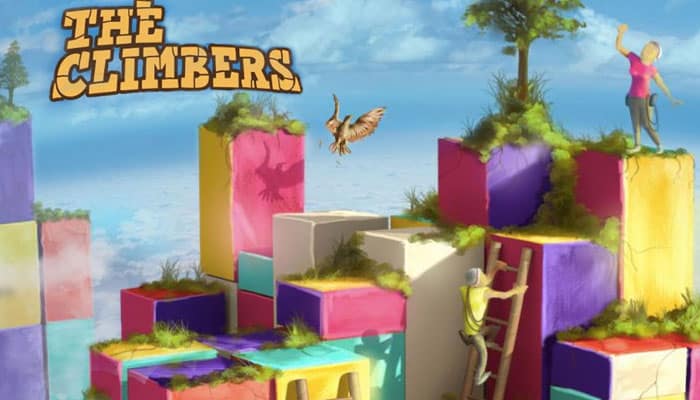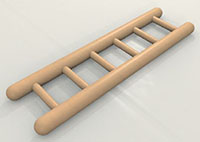
They gazed at the large structure of colorful blocks neatly stacked before them. The goal was simple: climb to the highest level possible. Getting there was more challenging than original- ly thought. Only one climber will make it to the top. Will it be you?
Your goal is to climb to the highest level of the structure. To help with your climb, you may move and rotate blocks. Ladders can be used to climb large distances.
Your blocking disk will prevent other players from using a specific block. Use your tools wisely and at the right time to make the best possible moves in your adventure to the top!

Components
- 2 neutral blocks
- 12 colored blocks, size 1
- 12 colored blocks, size 2
- 9 colored blocks, size 4
- 5 climbers
- 5 blocking disks
- 5 short ladders
- 5 long ladders
The Colored Blocks
The Climbers can only be placed on a surface of their own color or on the neutral surface. Therefore, all surfaces except the neutral surface may only be occupied by 1 Climber. Multiple Climbers may occupy the same neutral surface if there is enough space.

Climbers of all colors may occupy neutral surfaces.
Otherwise, the color of the Climber must match the color of the surface.

The blocks are divided into smaller, imaginary squares to accommodate Climbers.
The grid is used to prevent any ambiguous situations of placing blocks by ensuring at least 1 smaller square matches up with that of another block.
Size 1 Blocks
These blocks can be placed horizontally (laying) or vertically (standing). In the horizontal position, up to 4 Climbers can occupy the neutral square surface. The height of the block in this position is 1, which is the eye height of the Climbers. This height of 1 is the height a Climber can climb without requiring a ladder.
In the vertical position, the height of the block is 2. A ladder is required to climb a Size 1 block in the vertical position. When oriented vertically, up to 2 Climbers may occupy the neutral rectangular surface of the Size 1 block.
 Size 1 blocks can be ascended without a ladder. |
Size 2 Blocks
These cubes each have a square neutral surface which can be occupied by a maximum of 4 Climbers. These blocks have a height of 2 in all orientations. A ladder is required to climb these blocks.
 Size 2 blocks require at least a short ladder to climb |
 The neutral surface is fully occupied. The teal Climber cannot climb to the neutral surface! |
Size 4 Blocks
These blocks can be placed horizontally (laying) or vertically (standing). In the horizontal position, all Climbers can occupy the neutral rectangular surface. The height of the block in this position is 2. A ladder is required to climb this distance.
In the vertical position, the height of the block is 4. A long ladder is required to climb a height of 4. When oriented vertically, up to 4 Climbers may occupy the neutral square surface of the Size 4 block.
 Size 4 blocks require a long ladder to climb. |
 All 5 Climbers may occupy the neutralsurface on the horizontal side of a Size 4 block. |
The Ladders
In general, any distance greater than the height of your climber requires the use of a ladder.
A Climber can freely climb a difference of height 1 (equal to the height of a horizontal Size 1 block). To overcome a distance greater than a height of 1, a ladder is required!
Short ladders can be used for a height of 2. Long ladders can be used for a height of 2, 3, or 4. Ladders may only be used to climb the sides of a block. Ladders may not be used to climb diagonally.
Both ladders may be used on the same turn. However, the Climber must reach a surface in between using both ladders. Therefore, both ladders may not be combined into a single, very long ladder.
Once used, the ladder is immediately removed from the game.
 Short Ladder |
 Long Landder |
The Blocking Disks
During their turn, the player may place their blocking disk on any unoccupied, free surface. This block is now blocked for the next round. It cannot be occupied, crossed, or moved. Other blocks may not be moved on top of this block.
A blocking disk may be placed on any colored surface, including neutral. After one round, when play returns to the player who originally placed the blocking disk, the blocking disk is removed from the game.
 Blocks with blocking disks may not be moved or occupied by any Climber for one round. |
Setup
-
Place the 2 large neutral blocks vertically next to each other in the middle of the table. All colored blocks are then randomly built around these so that both neutral blocks are completely hidden.


All players can join together in building this structure! We recommend placing the larger blocks closer to the bottom and the Size 1 blocks towards the top.
Blocks may be offset, like bricks in a wall. However, the undersurface of each block must have full contact with the blocks underneath - there cannot be any holes or overhanging blocks!
-
Each player randomly chooses a Climber and takes the corresponding blocking disk, plus one short ladder and one long ladder.

-
Place all Climbers on the table near the structure of blocks.

Holes and overhanging blocks are not allowed! Blocks must have full contact of their bottom side with the block(s) under- neath.

Game Play
The player who most recently climbed a mountain goes first. Otherwise, the starting player is determined randomly. Players take turns in clockwise order from the start player.
On their turn, a player may Move their Climber as far as legally possible. This includes horizontal and upward movement. The player may also, at any time during their turn, move and/or rotate 1 unoccupied block.
The player may also use their blocking disk and/or any of their ladders at any time during their turn.
Move Climber
Climbers may only touch surfaces matching their color or the neutral color.
A player may never move their Climber diagonally onto another block or down- ward to another block!
Climbers may not enter a surface that exceeds the limit of allowable Climbers
A player may use one or both of their ladders on the same turn
If able, the other players may move their Climber upward (following turn order) after the current player completes their turn.
 The Red Climber is able to climb 2 steps in one move. |
 The Purple Climber cannot cross diagonally to the next block. |
 The Purple Climber may now move up to the topmost surface. |
Move Blocks
All unoccupied blocks, except for the block moved by the previous player, may be moved - including the large neutral blocks.
Blocks may be placed anywhere else with at least one of its sides touching the main structure. Blocks may be rotated and placed back in the same spot.
Players may look under a block to investigate the upper surface below. This block may be placed back in its original space and is considered to not have moved, provided it has not been rotated.
It is possible to split the main structure into isolated parts.
Players may place a block on another block occupied by one or more Climbers by pushing the Climbers to make room for the block. Climbers may not be displaced from the block they occupy when placing the block.
 This Size 1 block displays the minimum requirements for placing a block: One of its imaginary squares touches another on the main structure. |
 Climbers may be pushed in order to place a block. |
End of the Game
Play continues until each player consecutively fails to move their Climber upward on their respective turn. The winner is the player with the Climber that has reached the highest level.
If more than one Climber is at the same height, the Climber that reached that height first is the winner.
Continue Reading
